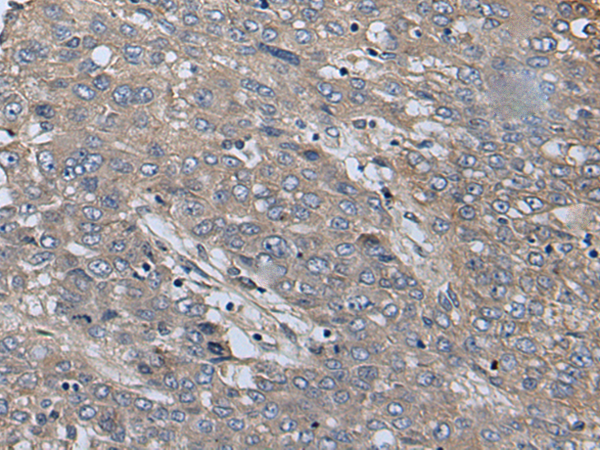
| WB | 咨询技术 | Human,Mouse,Rat |
| IF | 咨询技术 | Human,Mouse,Rat |
| IHC | 1/25-1/100 | Human,Mouse,Rat |
| ICC | 技术咨询 | Human,Mouse,Rat |
| FCM | 咨询技术 | Human,Mouse,Rat |
| Elisa | 1/5000-1/10000 | Human,Mouse,Rat |
| Aliases | NET34; ZIP14; cig19; LZT-Hs4 |
| Host/Isotype | Rabbit IgG |
| Antibody Type | Primary antibody |
| Storage | Store at 4°C short term. Aliquot and store at -20°C long term. Avoid freeze/thaw cycles. |
| Species Reactivity | Human, Mouse |
| Immunogen | Fusion protein of human SLC39A14 |
| Formulation | Purified antibody in PBS with 0.05% sodium azide and 50% glycerol. |
+ +
以下是3篇关于SLC39A14抗体的相关文献概览:
1. **"SLC39A14 Deficiency Leads to Manganese Accumulation in Tissues"**
- **作者**: Park JH et al. (2017)
- **摘要**: 该研究利用特异性SLC39A14抗体进行免疫组化和Western blot分析,发现SLC39A14基因敲除小鼠出现锰在肝脏和脑部异常蓄积,揭示了其在系统性锰稳态中的关键作用。
2. **"ZIP14 (SLC39A14) Modulates Hepatic Zinc Metabolism during Inflammation"**
- **作者**: Aydemir TB et al. (2016)
- **摘要**: 通过SLC39A14抗体检测肝细胞膜定位,发现炎症信号(如IL-6)上调该蛋白表达,促进锌离子转运至肝脏,参与急性期反应调控。
3. **"SLC39A14 Controls Iron Overload in a Murine Model of Hemochromatosis"**
- **作者**: Troche C et al. (2016)
- **摘要**: 使用SLC39A14抗体验证肠道和肝脏组织中的蛋白表达,证明其缺失加剧遗传性血色素沉着症小鼠模型的铁过载表型,提示其作为铁转运蛋白的功能。
4. **"The Zinc Transporter ZIP14/SLC39A14 Suppresses Nonalcoholic Fatty Liver Disease"**
- **作者**: Hojyo S et al. (2014)
- **摘要**: 通过抗体介导的SLC39A14蛋白检测,发现其在高脂饮食小鼠肝细胞中表达降低,导致锌代谢紊乱和脂肪肝进展,提示其潜在代谢保护作用。
**备注**:若需具体文献来源(期刊名/DOI),可进一步提供关键词辅助检索。
The solute carrier family 39 member 14 (SLC39A14), also known as ZIP14. is a transmembrane zinc/iron transporter involved in cellular metal homeostasis. It facilitates the uptake of divalent cations, including zinc (Zn²⁺), iron (Fe²⁺), and manganese (Mn²⁺), across plasma or organellar membranes. SLC39A14 is highly expressed in metabolically active tissues, such as the liver, intestines, and pancreas, where it regulates systemic and local metal distribution. Dysregulation of SLC39A14 has been linked to metabolic disorders (e.g., hemochromatosis, diabetes), neurodegenerative diseases (e.g., Parkinson’s), and cancers due to its role in metal-mediated signaling and oxidative stress.
Antibodies targeting SLC39A14 are critical tools for studying its expression, localization, and function. They enable detection via techniques like immunohistochemistry (IHC), Western blot (WB), and immunofluorescence (IF). Researchers use these antibodies to investigate tissue-specific metal transport mechanisms, disease-associated mutations, and therapeutic targets. For example, studies have utilized SLC39A14 antibodies to identify its upregulation in hepatocellular carcinoma or loss-of-function mutations in manganese toxicity models. Validation of antibody specificity (e.g., knockout controls) is essential due to potential cross-reactivity with other ZIP transporters. Overall, SLC39A14 antibodies advance insights into metal biology and pathologies linked to disrupted ion homeostasis.
×